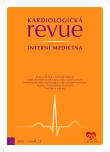The importance of treatment of arterial hypertension in the primary and secondary prevention of strokes
Authors:
Gašpar Ľ. 1,2; Murín J. 1
Authors‘ workplace:
I. interná klinika LF UK a UN Bratislava, Slovensko
1; Inštitút fyzioterapie, balneológie a liečebnej rehabilitácie v Piešťanoch, Univerzita sv. Cyrila a Metoda v Trnave, Slovensko
2
Published in:
Kardiol Rev Int Med 2020, 22(2): 75-77
Overview
Elevated blood pressure is a major modifiable risk factor for stroke. There is sufficient scientific evidence that antihypertensive treatment significantly reduces the risk of stroke. In the primary prevention of stroke, a higher efficacy of intensive antihypertensive treatment was confirmed, compared to less intensive methods. However, keeping in mind the prevention of serious adverse events, it is important to follow the current ESC/ESH Guidelines for the management of arterial hypertension. In antihypertensive treatment for the secondary prevention of stroke, emphasis is placed on its individualisation taking into account the etiopathogenesis of its development (mainly the extent and localisation of atherosclerotic plaques).\
Keywords:
blood pressure – stroke – primary stroke prevention – secondary stroke prevention
Sources
1. Borghi C, Tartagni E. The older patient with hypertension: care and cure. Ther Adv Chronic Dis 2012; 3(5): 231–236. doi: 10.1177/ 2040622312452189.
2. Owolabi MO, Aqunloye AM. Risk factors for stroke among patients with hypertension: a case-control study. J Neurol Sci 2013; 325(1–2): 51–56. doi: 10.1016/ j.jns.2012.11.016.
3. Turnbull F, Neal B, Ninomiya T et al. Blood pressure lowering trialist collaboration. Effect of different regimens to lower blood pressure on major cardiovascular events in older and younger adults: meta-analysis of randomised trials. BMJ 2008; 336(7653): 1121–1128. doi: 10.1136/ bmj.39548.738368.BE.
4. Jacquin A, Hervieu-Begue M, Daubail B et al. Epidemiology of stroke in the elderly: „The Silver Tsunami“. Rev Prat 2012; 6(9): 1221–1224.
5. Kim BJ, Cho YJ, Hong KS et al. Trajectory groups of 24 hour systolic blood pressure after acute ischemic stroke and recurrent vascular events. Stroke 2018; 49(8): 1836–1842. doi: 10.1161/ STROKEAHA. 118.021117.
6. Huang Y, Cai X, Li Y et al. Prehypertension and the risk of stroke: a meta-analysis. Neurology 2014; 82(13): 1153–1161. doi: 10.1212/ WNL.0000000000000268.
7. Benjamin EJ, Virani SS, Callaway CW et al. Heart disease and stroke statistics – 2018 update: a report from the American Heart Association. Circulation 2018; 137(12): e67–e492. doi: 10.1161/ CIR.0000000 000000558.
8. O’Donnell MJ, Chin SL, Rangarajan S et al. Global and regional effects of potentially modifiable risk factors associated withacute stroke in 32 contries (INTERSTROKE): a case-control study. Lancet 2016; 388(9735): 761–775. doi: 10.1016/ S0140-6736(16)30506-2.
9. Gorelick PB, Qureshi S, Farooq MU. Management of blood pressure in stroke. Int J Cardiol Hypertens 2019; 3(100021): 1–6. doi: 10.1016/ j.ijchy.2019.100021.
10. Benavente OR, Coffey CS, Conwit R et al. Blood--pressure targets in patients with recent lacunar stroke: the SPS3 randomised trial. Lancet 2013; 382(9891): 507–515. doi: 10.1016/ S0140-6736(13)60852-1.
11. James PA, Oparil S, Carter BL et al 2014 evidence-based guideline for the management of high blood pressure in adults: report from the panel members appointed to the Eighth Joint National Committee(JNC 8). JAMA 2014; 311(5): 507–520. doi: 10.1001/ jama.2013.284427.
12. Karavidas A, Lazaros G, Tsiachris D et al. Aging and the cardiovascular system. Hellenic J Cardiol 2010; 51(5): 421–427.
13. Chen HI. Hemodynamic mechanism of ventricular hypertrophy in hypertension. Chin J Physiol 2012; 55(6): 369–379. doi: 10.4077/ cjp.2012.baa088.
14. Lionakis N, Mendrinos D, Sanidas E et al. Hypertension in the elderly. World J Cardiol 2012; 4(5): 135–147. doi: 10.4330/ wjc.v4.i5.135.
15. Tuzcu EM, Kapadia SR, Tutar E et al. High prevalence of coronary atherosclerosis in asymptomatic teenagers and young adults. Evidence from intravacular ultrasound. Circulation 2001; 103(22): 2705–2710. doi: 10.1161/ 01.cir.103.22.2705.
16. Mottillo S, Filion KB, Genest J et al. The metabolic syndrome and cardiovascular risk a systematic review and meta-analysis. J Am Coll Cardiol 2010; 56(14): 1113–1132. doi: 10.1016/ j.jacc.2010.05.034.
17. Waeber B, Feihl F. Hypertension. Effects of antihypertensive therapy on cognitive functions. Rev Med Suisse 2013; 9(369): 108, 110–111.
18. van den Ham HA, Klungel OH, Singer DE et al. Comparative performance of ATRIA, CHADS2, and CHA2DS2-VASc risk scores predicting stroke in patients with atrial fibrillation. JACC 2015; 66(17): 1851–1859. doi: 10.1016/ j.jacc.2015.08.033.
19. Pisters R, Lane DA, Nieuwlaat R et al. A novel user-friendly score (HAS-BLED) to assess one-year risk of major bleeding in atrial fibrillation patients: The Euro Heart Survey. Chest 2010; 138(5): 1093–1100. doi: 10.1378/ chest.10-0134.
20. Potucek P, Klimas J. Chronopharmacology of high blood pressure – a critical review of clinical evidence. Eur Pharm J 2019. doi: 10.2478/ afpuc-2019-0017.
21. Castilla-Guerra L, Fernandez-Moreno MC. Chronic management of hypertension after stroke: The role of ambulatory blood pressure monitoring. J Stroke 2016; 18(1): 31–37. doi: 10.5853/ jos.2015.01102.
22. Post-stroke antihypertensive treatment study: a preliminary result. PATS Collaborating Group. Chin Med J (Engl) 1995; 108(9): 710–717. doi: 10.1016/ S0140-6736(01)06178-5.
23. PROGRESS Collaborative Study Subgroup. Randomized trial of perindopril-based blood-pressure-lowering regimen among 6108 individuals with previous stroke or transient ischemic attack. Lancet 2001; 358(9287): 1033–1041.
24. Ovbiagele B. Low-normal systolic blood pressure and secondary stroke risk. J Stroke Cerebrovasc Dis 2013; 22(5): 633–638. doi: 10.1016/ j.jstrokecerebrovasdis.2011.12.003.
25. Keun-Sik H. Blood pressure management for stroke prevention and in acute stroke. J Stroke 2017; 19(2): 152–165. doi: 10.5853/ jos.2017.00164.
26. Williams B, Mancia G, Spiering W et al. 2018 ESC/ ESH Guidelines for Management of Arterial Hypertension. Eur Heart J 2018; 39(33): 3021–3104. doi: 10.1093/ eurheartj/ ehy339.
Labels
Paediatric cardiology Internal medicine Cardiac surgery CardiologyArticle was published in
Cardiology Review

2020 Issue 2
Most read in this issue
- Modified Valsalva manoeuvre in pre-hospital care – a case report
- Urapidil – an antihypertensive drug with a dual action mechanism
- Clinical experience in the use of the infusion fixed combination Neodolpasse (diclofenac/ orphenadrine) in the postoperative period in cardiac surgery patients
- Cardiovascular prevention news
